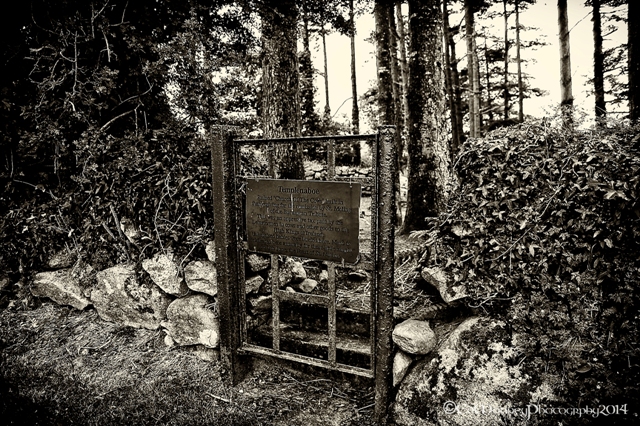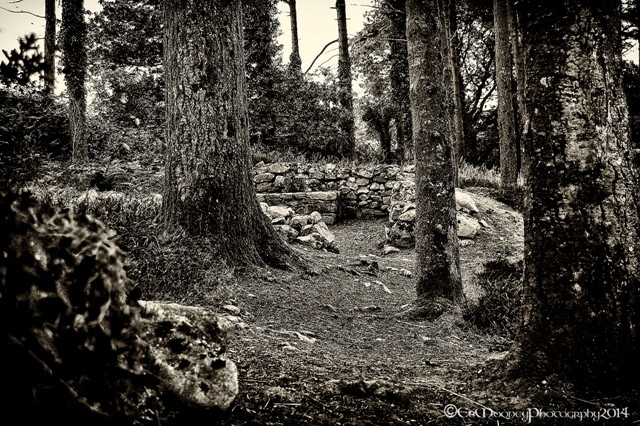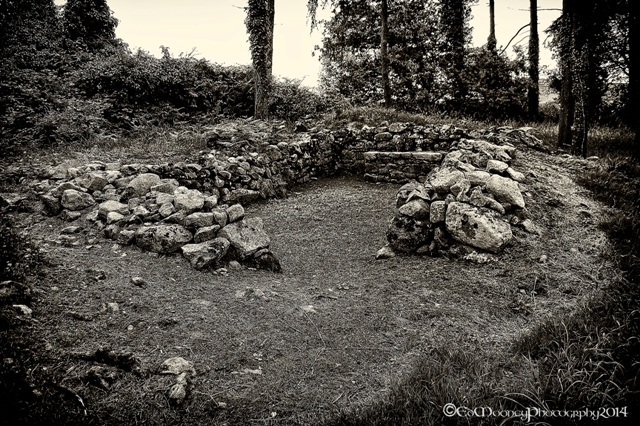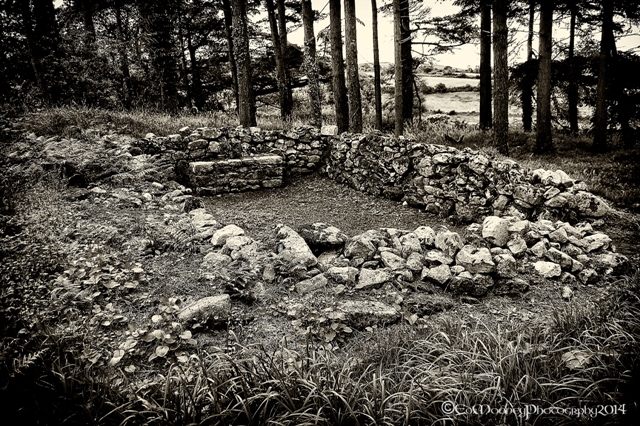It’s been a hectic few days, after taking the week of work for some badly needed R&R I think I will be going back to work on Monday for a rest. I spent the last few days with the family, were we made the most of our time, and treated it like a proper holiday, but more about that later. I just noticed I had not posted this week aside from my regular schedule. So to end the week here is a nice little ruin with a cool history. Teampall na Bó or ‘The Church of the Cows’, is a small medieval church located a short distance north from the Monastic Settlement at St. Mullins in Co. Carlow.
I cant find a date for its construction, but the small church was believed to have been built to commemorate St. Moling whom freed the people of Leinster from the Borumean Tribute. We all know how complicated Irish history can be so please bear with me as I try to explain this fascinating story. The source of our story of the Borumean Tribute comes from the ‘Lebor na Nuachongbála’ which was written partially in Oughavel, and is now more commonly known these days as the ‘Book of Leinster’ or ‘Lebor Laignech’ in Gaelic. It is a medieval Irish manuscript compiled around 1160AD and is now kept in Trinity College, Dublin. Reading it is quite hard and tedious work, as it was written in old Irish so the English translations are difficult at best.
It all started with the Ard Rí or High King known as Tuathal Techtmar, whom had taken control of all Ireland by force. To cut a long story short Tuathal had two daughters, Fithir and Dáirine. Eochaid the king of Leinster took the younger daughter Fithir whom was fostered to the King of Connacht, as a wife and brought her back to Leinster and his home at Ráth Imil. When he arrived home his advisors told him that he had chosen the lesser of the two daughters and so Eochaid went back to Tara and told Tuathal that the girl had died. He was then given Dáirine whom had been fostered to the King of Ulster, and he took her back to Ráth Imil. As the story goes when Fithir saw Dáirine, she died of shame. Then likewise Dáirine died of grief after witnessing her sister’s death. As you could imagine, the news of Eochaid’s treachery quickly spread back to Tara and Tuathal, whom immediately sought vengeance for the deaths of his beloved daughters. Eochaid’s greed and deceit backfired on him. The armies of Ulster, Connacht and Muster joined forces with the armies of Tuathal and they waged a bloody campaign against Eochaid and the armies of Leinster which resulted in Eochaid’s death. As punishment under Brehon Law a blood price still had to be paid for the lives of Fithir and Dáirine. This was the Bórama, or Borumean Tribute which consisted of an annual payment of 5,000 cows, 5,000 sheep, 5,000 hogs, 5,000 cloaks, 5,000 bronze vessels, and 5,000 ounces of silver.
This was paid annually by the kingdom or people of Leinster, and here is where the details become unclear. The Book of Leinster mentions some battles and lifting of the tribute, including the involvement of Fionn McCumhaill and the Fianna. However, although not mentioned, this seems to tie in to the battle of Gabhra at which the Fianna were destroyed by the armies of the rest of Ireland and timelines don’t fit, although the events may do so. Back to our story after about five centuries of this tribute which was seen as oppressive by the people of Leinster. St. Molling was credited which having the tribute abolished for good. Teampall na Bó which I would say was not built until much later, commemorates this important time.
What remains of this little church is not much. the structure itself is about 8.5 meters in length and5 meters wide. The remaining walls are no more than a meter in height all built from drystone masonary. To the east end of the church there is still a small stone alter. Although the site is scarce and hidden away amongst the trees, I found it to be very peacefull and calm. It is believed that unbaptised children were buried here, although there is little sign of any grave markings in the area. Mass is said here each year for these little children whom have passed away, on the feast day of St. Moling 17th June.
To see more of these images, why not visit my Website or join me on Facebook or Twitter.











looks eerie, great pic!
LikeLiked by 1 person
Thank you 🙂
LikeLiked by 1 person
Reblogged this on Palabras Perdidas.
LikeLike
What a lovely place, all secreted away in a clearing in the woods! Ed, I really loved that story. I think Tuathal Techtmar is considered to be a genuine king in ancient Irish history, isn’t he, and he was supposed to have lived in the 1st century AD. Fionn and the Fianna were supposed to have lived in the 3rd century AD, their Ard Ri was Cormac. I really sensed the feeling of peace you said you felt by looking at these images. Very beautiful…
LikeLiked by 1 person
Thanks Ali, Your dead right, he was a genuine Ard Ri, what was confusing in the Book of Leinster was that both stories mentioned Cairbre the son of Art, the son of Conn of the Hundred Battles. And both events surrounded a tribute! Gets fierce confusing reading the old stuff. Timelines and some names always tend to get mixed up along the way:-)
LikeLike
The names alone are enough to make me go boggle-eyed! As for my poor aged brain cells ( not that many left of them… I blame motherhood.) They’re just too damn feeble to cling on to odd names and dates lol! Can’t do numbers. Yeah, and I’m not the only one, those damn monks clearly got a bit confused themselves! Either that, or they imbibed a bit too much of that there mead and magic mushrooms…
LikeLiked by 1 person
MMMNNn Mead, haven’t had that in a while. I struggle just keeping the stories right in my head. Dates really mess me up. I never heard of the monks taking the fly agaric. I know some Druids would have used them for their spiritual work. If memory serves me, we should be coming into shroom season shortly 🙂
Anyone for a cup of tea???
LikeLike
Interesting story and great pics…Love the mood that you created with the lighting.
LikeLiked by 1 person
Glad to hear you had some R&R with the family Ed.
LikeLiked by 1 person
Cheers Rob, I even managed to sneak in a few more sites 🙂
LikeLike
Great story, very much enjoyed reading this, Ed! Your comments with Ali are far above anything I understand about the history, such wonderful history. I try to imagine what it would be like to be in that church when it was new. A different world really.
LikeLiked by 1 person
Hope you had a wonderful R&R. Great pictures and the history you tell is fascinating. Really enjoy the stories and pics.
LikeLiked by 1 person
Thank you Jack 🙂
LikeLike
Pingback: Ráth Lóegaire | Ed Mooney Photography